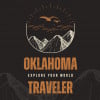Writing a book... 2 Questions
For the last two years, I've been wading knee deep in historic documents, court transcripts, and semi-pointless stories. The point? To write a book chronicling the growth of a proto-typical Oklahoma town. So far, I've reached nearly 40,000 words, not including notes. I have about another 50,000 to go, but there were a couple issues that came about today. Hopefully someone will have some input on this.
First, photos. I have a large collection of photographs from the late 1800's/early 1900's that I would love to use in the book. I always like to get permission before using any photo, but in this case, it is unclear who the owners of the pictures are. I don't completely understand the copyright laws on old photographs, and was hoping that someone here may be able to clarify if I'm able to use them or not.
...and Second, footnotes. It is my intent to make this book both easily readable and entertaining (Flesch Reading Ease 62, Grade Level 8.6), however, since this is a historic book I'm not certain if I should use footnotes to cite my references. I've seen books with this as well as books without. What is the standard recommendation on using footnotes, and how is it determined what to include?
If anyone has any tips or suggestions, I would greatly appreciate them.
Thanks!One more, which I forgot to ask last night..
In the book, there area number of stories from people that lived in the late 1800's. They're all gone now, but their stories survive in various places. For example, I have a court record of a specific gunfight that lists the names of several people. I've included this story in the book. My question is this: Do I have to ask permission from anyone to use this information in my book?
I always assumed that this wouldn't be a big deal, but I've never gone into the legalities of it.
Thanks!In my understanding, no legal action can be taken on behalf of a dead person. This would imply you can use the information freely.
That's pretty much what I thought. Some of these stories are pretty rough and give away some family "secrets", so to speak. I don't want to make any family look bad, but at the same time I believe these old stories should be told - especially since they help move the book forward. I don't think anyone would mind - especially since things happened more than 100 years ago, but always better to lean on the safe side.
Any ideas about the photos and footnotes?
Thanks for the help..
Hi,
Urbane Chaos,
I'm in the process of self-publishing my tarot book, but am working with a publisher for the marketing part. For some reason, the year 1916 is in my mind that copyright laws came into being. The tarot cards I used were drawn in 1909, so were not covered under that law, are part of the public domain. I put pictures on several groups of pages or plates that were in relevant parts of the book, and it flows nicely. People may like to read footnotes if they are interested in your subject, but it's still nicer to mark the spot in the book, and put the notes in the back, listed chapter by chapter. Best of luck!I've never had any problems with photos in magazines, but this is a completely different animal. If I was in possession of the actual photos then I wouldn't be concerned. But, I've noticed that with some of the photos that I was planning on using, new copyrights have been put in place. From what I understand, if they even add a border and a line of text, then the photo is considered copyright. Of course, I may be wrong, which I hope I am. I'll know more when I hear back from the copyright office.
If the work is still under copyright (which does apply to unpublished letters etc) it belongs to the person's estate, who would therefore have legal standing.
Urbane Chaos mentioned court records, which I presume are in the public domain.
I don't know about newspaper stories, nor about copyright on old photographs. I had to learn about UK copyright law once, but that was a long time ago. We did not cover US law in any detail.
The US Copyright Office has a form on their web site specifically for queries about copyright: http://www.copyright.gov/help/
As for footnotes/endnotes:
Providing bibliographical references would add credibility to the book in my opinion and would be a useful source for anyone wanting to do research into the history of the region.
Having notes also provides a place to put in extended commentaries/fascinating facts concerning issues that are more distantly related to the main theme of the book. Sometimes such notes can be very rewarding to read.
The problem with endnotes is having to leaf through to one, because the context is interesting, only to find that particular endnote is just a dry bibliographical reference rather than a commentary. I've also sometimes read a book without wanting to be bothered to turn to endnotes. Then I flicked through at the end and found them full of extended notes with really interesting facts, which would have enriched my reading experience if read in context.
With footnotes, the reader simply needs to glance down the page and decide whether to read the note. The problem with footnotes is that bibliographical references are not gathered together in a convenient list.
My personal choice would be to put any additional commentaries as footnotes, and use endnotes for lists of bibliographical references to the material consulted.With the copyright law, I sent an email asking several specific questions, but haven't heard anything back yet. Hopefully they'll be able to help, as long as my email didn't get dumped for some reason..

I think I really like your idea with the footnotes. Usually, I never include bibliographies or footnotes, but I'm also writing something completely different than anything I've ever done before. Since it's information that most people don't know, I wanted to be very specific about where the information came from. But, the footnotes end up taking up a lot of space, and I think that detracts from the readability of the book.
I think you're right here: Footnotes for interesting tidbits that don't don't belong in the main text, and a complete and separate bibliography at the end for reference and further research. At least, I think that's the basic idea you're saying..
Thanks for the help!!!
For the most part, all of the information that I have has been through public records searches, court documents and transcripts, and so on - so I'm not concerned about that.
Other information has come from recorded interviews where the person being interviewed gave me permission to use the information. I've tried my best to cross my I's and dot my T's, so to speak.
The biggest concern I have is with old images that have been shared online. For example, there was a guy that published a lot of these photos online, but he passed away a few years ago. Unfortunately, after he died, many of those pictures were simply thrown away. They ranged in date from 1880-1920. It is my assumption that these are no longer under copyright, but I want to make sure before I use them.
WriteAngled had lots of good information for you Urbane Chaos. I would have to agree with her. I thought, on copyrights, this link from Cornell University might help:
http://copyright.cornell.edu/resources/publicdomain.cfm
Basically, it depends on how old the work is. It sounds to me like any photograph you have from before 1890 or so should be fair game (of course 89 being the land run means photos of it are now public domain. This link should help quite a bit with this. If you can find family of anyone who took the pictures or is in the picture, getting their permission could possibly save you some time down the road if they took exception to your use of it. Of course if the persons are unknown, this cannot be done.
Also, as for footnotes. I was a little unsure (perhaps I missed it) if this is a fictionalized work or a historical work of non-fiction. If it is non-fiction, I would say you absolutely should include footnotes/end notes. Not only does this make your book more usable in the academic field, but it readily establishes the fact you've done your due diligence and are indeed an authoritative voice on your subject matter. If it is fiction, it is something you can decide with your editor when it comes time to publish. They will probably have good advice on this issue, though I tend to agree with Urbane Chaos that footnotes make reading the work more informative and less disruptive.From that link you provided, it looks like the majority of what I have is no longer copyrighted. The only thing that I've found so far that I'm not allowed to use is the old Sandborne maps. They're now stored in the Library of Congress, but after I inquired about it, they said that I could create separate maps, but I couldn't use the ones that already exist - which I found fascinating.
It also looks like the copyrights have expired on a lot of the photographs that I have. Unless I hear back from the copyright office, I plan on going ahead and using them.
There are some that I obtained from the Chamber of Commerce. I seriously doubt that they hold any copyrights on the material, but like you said, I'll double check with them to make sure before I publish.
The work is non-fiction historical account of the area. In some instances, I've had to "flesh" out the writing a little to make the stories make sense, but I plan to add that in with the authors notes. Basically, each chapter begins with a descriptive story to set the mood, so to speak.
As I mentioned to WriteAngled, I think the best thing that I can do is to use footnotes to interject needed information or interesting tidbits, and then use a full bibliography at the end.
Thanks for the help!
I didn't see all of the conversation here, but to be specific, after a number of years (and the time frame you are talking about seems WELL within the "safe range" off the top of my head) a copyright DOES expire.
I thought that too, but I'm glad that I double checked on things. As I just mentioned, I found out that the old Sandborne maps that I have are still under copyright, even though they range from 1899 to 1924.
From what I understand, they took the old maps and digitized them. In the process, they added small features in order to make the maps more readable. The original paper maps are no longer available, at least for this area anyway. So, once they digitized them, the copyrights went back into effect.
Another instance was when I was writing an article about Captain Reynolds. (not the article on here) I found an old picture of him and included it with my publication. After I submitted it, the paper said that the photo was still under copyright. Even though the actual picture was taken in the late 1800's, the owner refused me the right to use it. I found it through a genealogy link, and I just assumed that since it was an old picture that it could be used. I had to scramble to find another photo, but I'm glad that the paper followed through and double checked everything. Otherwise, I'm sure I could have gotten into a lot of trouble over that.
Since then, I've always been very careful about what photos I use. With the photos that I'm not sure about either I can't find the owner, or the owner has passed away. This is really where the dilemma originates. I'd hate to go through all this work and then end up getting sued because of something silly.
Hopefully the copyright office will have some good advice for me.
Thanks for the help! I'm sure that it'll all be fine, but I don't want to take any chances..Your book sounds really interesting! Let us know how it all works out. I often refer to footnotes in the back after I read a book, if I'm interested in the topic, it can refer me to further reading.
Related Discussions
- 32
photos and copyrights...
by Jeff Davis 15 years ago
is it necessary to cite the origin of your photos if you downloaded them from somewhere? and is it necessary to copyright or somehow mark photos posted that you yourself has taken? thank you in advance for any input.
- 69
where does everyone get there photos from and how to avoid copyright??
by markbennis 15 years ago
Hello all, this might seem a stupid one but I still haven't figured it out yet. What is the score with applying photos to your hub, I mean can you just scroll the web and copy any photo you like?? I'm confused.... I understand the video aspect and that's cool embedded Url?? well...
- 25
MyFreeCopyRight.com has deleted all all accounts from before June 2012
by Anthony Goodley 12 years ago
After noticing a bunch of broken links appearing on my hubs I traced the problem to where I link to MyFreeCopyRight.com on each of my hubs. When I tried to login to MFC it said I didn't have an account at all. Next I tried to email the website several times and have as of yet to receive a...
- 5
I'm a song writer and I want to know how to copyright my lyrics-..Anyone know?
by Kirst Lou 13 years ago
I'm a song writer and I want to know how to copyright my lyrics-..Anyone know?
- 33
Using old photographs in historical hubs
by ruthwalker 11 years ago
Hi there, joined HP a little while ago but only just got round to writing my first hub. It is going to be an historical piece but seem to be spending most of my time trying to find who owns copyright to the images I would like to use, which are all dated between 1920's and 1950's, and then trying...
- 8
Photo Copyrights
by Writer Rider 16 years ago
I try my best to abide by the law. Can someone tell me about the use of photos. I think I read somewhere that you have to have permission if you are using photos from a website. This is just a clarification of the rules. Thanks.










